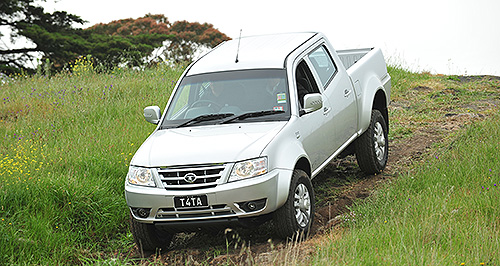News - Tata - XenonTata confident on Xenon’s crash-test abilityTough call: Tata will set cheap-ute safety benchmarks by introducing electronic stability control on the Xenon ute from early next year. Extra safety flagged for tough Tata Xenon ute – if the market demands it25 Oct 2013 By BARRY PARK TATA has talked up its chances of making a dent on cheap ute safety records, saying its Xenon ute should perform well when assessed by Australia’s crash safety watchdog. The Indian car-maker believes its Xenon ute, launched on the Australian market this week, will perform well when the Australiasian New Car Assessment Program crashes one to assess how well it performs. The Xenon launches in Australia with a driver and passenger airbag fitted as standard, as well as important features such as a seatbelt reminder for the driver, which should all help improve the Xenon’s crash-test score. ESC stability control will be added in January, although around 420 cars imported this year will be sold without. It’s unclear if ANCAP will test an ESC-equipped Xenon or an early-sale one without. The Xenon will compete with a range of low-priced commercial vehicles that have scored three-star ANCAP crash ratings, including the India-sourced Mahindra Pik-up and Chinese-made Great Wall V240 and Foton Tunland. None of these trade utes are fitted with potentially life-saving ESC – which can help a vehicle recover from a skid – a point of differentiation that Tata hopes will make the Xenon ute more attractive in the eyes of potential buyers. Tata introduced airbags on the Xenon specifically for the Australian market after the brand’s official Australian distributor, Fusion Automotive, said it would need them to compete at the cheaper end of the market. Fusion Automotive managing director Darren Bolwer said when talks between his company and Tata started, the Xenon lacked both airbags and electronic stability control. “(Fusion chief operations officer) Oliver (Lukeis) and I had discussions about what was required, what we wanted for the Australian market, and Tata was very open to listen to work with us and build airbags, to do Euro V and to produce ESC,” Mr Bolwer said. He said Tata was able to produce a version of the Xenon fitted with two airbags and an electronic safety net in only 18 months. Tata has flagged more airbags could be built into the Xenon over time to improve its crash safety, although it would depend on market demand. “It's a bit of which comes first,” Tata executive director of commercial vehicles Ravi Pisharody told GoAuto. “Unless you are in some markets with these types of demand and volumes, you don't have the need to invest in these features, but as we get into markets, we can have another look at adding more of those features to the list,” he said. He said introducing a version of the Xenon’s 2.2-litre turbo-diesel engine that complied with strict Euro V emissions standards was an example of how its vehicles could be modified to suit market needs. “Because Euro V is not something we have in most of the markets we play, but in Western Europe we found the need for some of the markets to require it. “I think you will discover more such features as we go along,” Mr Pisharody said. Tata plans sell more than 400 Xenon utes this year without ESC. The company said the system was still being fine-tuned, and would not arrive on Australian-bound models until January next year.  Read more |
Click to shareTata articlesXenon pricing
Motor industry news |
















Facebook Twitter Instagram